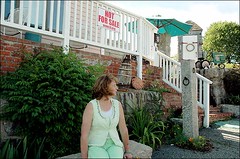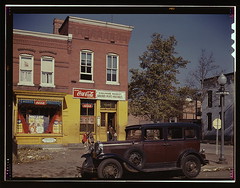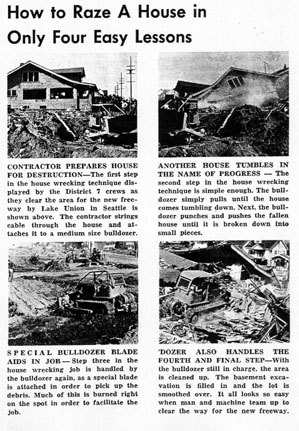A bit on eminent domain
No time to write a lot but this is something I wrote in email.
The opinion: KELO et al. v. CITY OF NEW LONDON et al.
 C. M. Glover for The New York Times. Susette Kelo bought her house in New London, Conn., eight years ago. Thursday, the Supreme Court allowed the property to be condemned.
C. M. Glover for The New York Times. Susette Kelo bought her house in New London, Conn., eight years ago. Thursday, the Supreme Court allowed the property to be condemned.These are tough and troubling issues--balancing the new and the old, attracting tax base, intensification of land use, density, etc. I look forward to attending the sessions on this topic at the conference in Portland.
Measure 37 is an attack on urban growth boundaries as a way to manage and focus development. However it was characterized, that is why the development lobby pushed this initiative forward. This law is about sprawl and keeping it going, rather than recentering and focusing more compact development patterns.
The Kelo case is about the use of public authority for what can be legitimately interpreted as extreme private benefit rather than "public use."
There are no easy solutions. Should I let my neighborhood of 2500 or so buildings constructed mostly before 1920 in favor of a number of tall (for DC) buildings? I don't know. My HP zealotry says no, absolutely not. OTOH, my support of urban growth boundaries, transit-oriented development and attracting people back to the city means it ought to be considered, especially as the neighborhood has two subway stations and will eventually be served by two streetcar lines as well.
But I do see this as a destruction of the qualities that make DC neighborhoods attractive to begin with--their historic buildings-architecture and pedestrian-centric urban design.
Maybe it would be easier to sign off on this if the results of the 1950s-1970s (and beyond) urban renewal weren't so poor.
I think it's ironic that Southwest DC, a pilot site for the national program of urban "renewal," where the entire neighborhood was leveled for towers in the park modernism, is going through a new phase of urban "renewal" out of necessity, because the neighorhood created isn't very successful in terms of circulation, retail, etc. OTOH, the DC neighborhoods typified by the kind of building stock destroyed in SW are experiencing almost insane levels of market demand for the historic housing that is still extant.
 Typical building stock destroyed in the Southwest DC Urban Renewal Program. Photo by Louise Rosskam, Farm Security Administration, circa late 1930s.
Typical building stock destroyed in the Southwest DC Urban Renewal Program. Photo by Louise Rosskam, Farm Security Administration, circa late 1930s.Or the old Convention Center was just torn down (and it was built on an area of historic downtown-Chinatown) because a new one was just built. Yet, the old building wasn't even 30 years old, and the debt service hasn't even been paid off...makes me question again the success of the kinds of "redevelopment" projects the Kelo case represents.
What the Kelo case represents to me is something fundamentally different from HP laws. I think of HP laws as balancing the rights of the individual with the concerns of the community, both the other immediate neighbors and the community at large. I think of the Kelo case as saying that balancing the rights of the individual vis-a-vis the community is no longer important, that the state can do anything and is more important than any other individual or community concerns.
This is accentuated by the fact that the political and economic system is subject to gaming and abuse of power. The people who benefit from eminent domain most often are the developers, not the people more generally, and not really the coffers of the local government. Logan and Molotch's Urban Fortunes: The Political Economy of Place is probably the best description around of these forces. For the Washington DC experience, read chapter 4 from the book Dream City.
Getting back to property rights advocates, I think they have similarly unbalanced arguments as they focus on the right of the individual property owner to the exclusion of any and all other legitimate public policy concerns.
I think it would be very difficult to work with such people (given some really ugly experiences I have right now in the heart of DC, which I haven't written about yet on this list) because it wouldn't be a true coalition based on a shared sense that balancing individual and community needs to be at the heart of such decision-making. Preservationists push balance. The property rights folk are concerned solely about individual property owners ability to have untrammelled authority over their domain.




0 Comments:
Post a Comment
<< Home